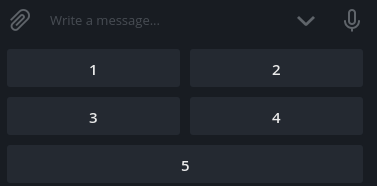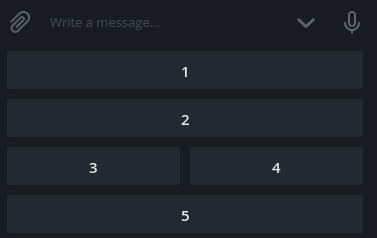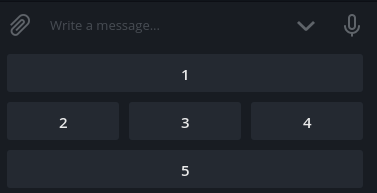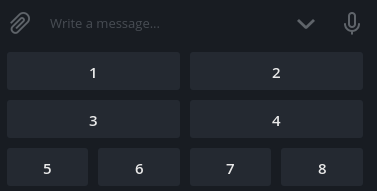Simple and powerful reply and inline keyboard builder for Telegram Bots
Just use npm
npm i telegram-keyboard --save
or yarn
yarn add telegram-keyboard
const Telegraf = require('telegraf')
const { Keyboard } = require('telegram-keyboard')
const bot = new Telegraf(process.env.BOT_TOKEN)
bot.on('text', async (ctx) => {
const keyboard = Keyboard.make([
['Button 1', 'Button 2'], // First row
['Button 3', 'Button 4'], // Second row
])
await ctx.reply('Simple built-in keyboard', keyboard.reply())
await ctx.reply('Simple inline keyboard', keyboard.inline())
})Reply (build-in) keyboard
const { Keyboard } = require('telegram-keyboard')
const keyboard = Keyboard.make(['Button 1', 'Button 2']).reply()
// or using shortcut
const keyboard = Keyboard.reply(['Button 1', 'Button 2'])
console.log(keyboard){
"reply_markup": {
"resize_keyboard": true,
"keyboard": [
[
"Button 1",
"Button 2"
]
]
}
}const { Keyboard } = require('telegram-keyboard')
const keyboard = Keyboard.make(['Button 1', 'Button 2']).inline()
// or using shortcut
const keyboard = Keyboard.inline(['Button 1', 'Button 2'])
console.log(keyboard){
"reply_markup": {
"resize_keyboard": true,
"inline_keyboard": [
[
{
"text": "Button 1",
"callback_data": "Button 1"
},
{
"text": "Button 2",
"callback_data": "Button 2"
}
]
]
}
}const { Keyboard, Key } = require('telegram-keyboard')
const keyboard = Keyboard.make([
Key.callback('Button 1', 'action1'),
Key.callback('Button 2', 'action2'),
]).inline()
console.log(keyboard){
"reply_markup": {
"resize_keyboard": true,
"inline_keyboard": [
[
{
"text": "Button 1",
"callback_data": "action1"
},
{
"text": "Button 2",
"callback_data": "action2"
}
]
]
}
}const { Keyboard } = require('telegram-keyboard')
const keyboard = Keyboard.make(['1', '2', '3', '4', '5'], {
columns: 2,
}).reply()
console.log(keyboard){
"reply_markup": {
"resize_keyboard": true,
"keyboard": [
["1", "2"],
["3", "4"],
["5"]
]
}
}const { Keyboard } = require('telegram-keyboard')
const keyboard = Keyboard.make(['1', '2', '3', '4', '5'], {
wrap: (row, index, button) => Math.random() > 0.5
}).reply()
console.log(keyboard){
"reply_markup": {
"resize_keyboard": true,
"keyboard": [ // different every time
["1", "2"],
["3"],
["4"],
["5"]
]
}
}In this example pattern: [3, 1, 1] means that the first row will have 3 buttons, the second - 1, the third - 1 and all the other buttons in the last row
const { Keyboard } = require('telegram-keyboard')
const keyboard = Keyboard.make([1, 2, 3, 4, 5, 6, 7, 8, 9, 10], {
pattern: [3, 1, 1]
}).reply()
console.log(keyboard){
"reply_markup": {
"resize_keyboard": true,
"keyboard": [
["1", "2", "3"],
["4"],
["5"],
["6", "7", "8", "9", "10"]
]
}
}Default filter function is button => !button.hide but you can pass your filtering function
const { Keyboard } = require('telegram-keyboard')
const keyboard = Keyboard.make([1, 2, 3, 4, 5, 6, 7, 8, 9, 10], {
columns: 2,
filter: btn => btn % 2
}).reply()
console.log(keyboard){
"reply_markup": {
"resize_keyboard": true,
"keyboard": [
["1", "3"],
["5", "7"],
["9"]
]
}
}const { Keyboard } = require('telegram-keyboard')
const keyboard = Keyboard.make([1, 2, 3, 4, 5, 6, 7, 8, 9, 10], {
columns: 2,
filter: btn => btn % 2,
filterAfterBuild: true
}).reply()
console.log(keyboard){
"reply_markup": {
"resize_keyboard": true,
"keyboard": [
["1"],
["3"],
["5"],
["7"],
["9"]
]
}
}const { Keyboard } = require('telegram-keyboard')
const keyboard = Keyboard.make([[1, 2], [3, 4, 5, 6], [7, 8, 9, 10]], {
flat: true,
columns: 3,
}).reply()
console.log(keyboard){
"reply_markup": {
"resize_keyboard": true,
"keyboard": [
["1", "2", "3"],
["4", "5", "6"],
["7", "8", "9"],
[ "10"]
]
}
}const { Keyboard } = require('telegram-keyboard')
const keyboard1 = Keyboard.make(['1', '2', '3', '4'], {
columns: 2
})
const keyboard2 = Keyboard.make(['5', '6', '7', '8'])
const keyboard = Keyboard.combine(keyboard1, keyboard2).reply()
console.log(keyboard){
"reply_markup": {
"resize_keyboard": true,
"keyboard": [
["1", "2"],
["3", "4"],
["5", "6", "7", "8"]
]
}
}Full example in examples/pagination.js
Instead of writing a separate function to create the keyboard like this:
const createKeyboard = page => {
return Keyboard
.make(/* ... */)
}You can pass function to Keyboard.make method. The function must return either an array of buttons or another keyboard. After that with the keyboard.construct(someArgs) method you can recreate it
const { Keyboard } = require('telegram-keyboard')
const items = [1, 2, 3, 4, 5, 6, 7, 8, 9, 10]
const itemsPerPage = 4
const keyboard = Keyboard.make((page) => {
const pageItems = items.slice(page * itemsPerPage, page * itemsPerPage + itemsPerPage)
return Keyboard.combine(
Keyboard.make(pageItems, { columns: 3 }),
Keyboard.make([
Key.callback('<----', 'left', page === 0),
Key.callback('---->', 'right', page === 2),
])
)
})
// remake keyboard with some other arguments
console.log(keyboard.construct(0).reply())
console.log(keyboard.construct(1).reply())More examples you may find in examples





